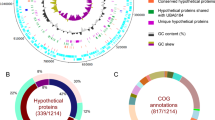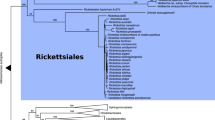Abstract
IN spite of the widespread occurrence of intracellular bacteria-like symbionts in eukaryotic cells little is known about their function1–3. They are generally thought to offer some advantage to the host cell while benefiting from its ‘hospitality’, but their precise contribution is known in few cases. Flagellates that harbour endosymbionts provide excellent models for the analysis of this relationship. Three trypanosomatids, Crithidia oncopelti, C. deanei and Blastocrithidia culicis harbour endosymbionts whose bacteria-like nature has been confirmed morphologically and biochemically4–9. Unlike symbiont-free species10, those species do not require haemin for growth because the endosymbionts provide haemm-synthesising enzymes11. We now report that endosymbionts enable certain species of Crithidia to synthesise arginine from ornithine.
This is a preview of subscription content, access via your institution
Access options
Subscribe to this journal
Receive 51 print issues and online access
$199.00 per year
only $3.90 per issue
Buy this article
- Purchase on Springer Link
- Instant access to full article PDF
Prices may be subject to local taxes which are calculated during checkout
Similar content being viewed by others
References
Buchner, P. Endosymbiosis of Animals with Plant Microorganisms (Wiley–InterScience, New York, 1965).
Trager, W. Symbiosis (Van Nostrand–Reinhold, New York, 1970).
Margulis, L. Origin of Eukaryotic Cells (Yale University Press, New Haven, 1970).
Newton, B. A. & Horne, R. W. Expl Cell Res. 13, 563–574 (1957).
Gill, J. W. & Vogel, H. J. J. Protozool. 10, 148–152 (1963).
Marmur, J., Cahoon, M. E., Shimura, Y. & Vogel, H. J. Nature 197, 1228–1229 (1963).
Gutteridge, W. E. & Macadan, R. F. J. Protozool. 18, 637–640 (1971).
Chang, K. P. J. Protozool. 21, 518–521 (1974).
Mundim, M. H., Roitman, I., Hermans, M. A. & Kitajima, E. W. J. Protozool. 21, 518–521 (1974).
Chang, K. P. & Trager, W. Science 183, 531–532 (1974).
Chang, K. P., Chang, C. S. & Sassa, S. Proc. natn. Acad. Sci. U.S.A. 72, 2979–2983 (1975).
Newton, B. A. Nature 177, 279–280 (1956).
Kroon, A. M. Biochim. biophys. Acta 72, 391 (1963); in Inhibitors Tools in Cell Research 159–166 (Springer, New York, 1969).
Mizutani, A. J. Histochem. Cytochem. 15, 603–604 (1967).
Bernhardt, S. A. & Davis, R. H. Proc. natn. Acad. Sci. U.S.A. 69, 1868–1872 (1972).
Weiss, R. L. & Davis, R. H. J. biol. Chem. 248, 5403–5408 (1973).
Roitman, C., Roitman, I. & Azevedo, H. P. J. Protozool. 19, 346–349 (1972).
Nakamura, M. & Jones, M. E. in Methods in Enzymology 17A, 286–294 (Academic, New York, 1970).
Archibald, R. M. J. biol. Chem. 156, 121–142 (1944).
Author information
Authors and Affiliations
Rights and permissions
About this article
Cite this article
CAMARGO, E., FREYMULLER, E. Endosymbiont as supplier of ornithine carbamoyltransferase in a trypanosomatid. Nature 270, 52–53 (1977). https://doi.org/10.1038/270052a0
Received:
Accepted:
Issue Date:
DOI: https://doi.org/10.1038/270052a0
This article is cited by
-
Biochemical and phylogenetic analyses of phosphatidylinositol production in Angomonas deanei, an endosymbiont-harboring trypanosomatid
Parasites & Vectors (2015)
-
Endosymbiosis in trypanosomatids: the genomic cooperation between bacterium and host in the synthesis of essential amino acids is heavily influenced by multiple horizontal gene transfers
BMC Evolutionary Biology (2013)
Comments
By submitting a comment you agree to abide by our Terms and Community Guidelines. If you find something abusive or that does not comply with our terms or guidelines please flag it as inappropriate.



